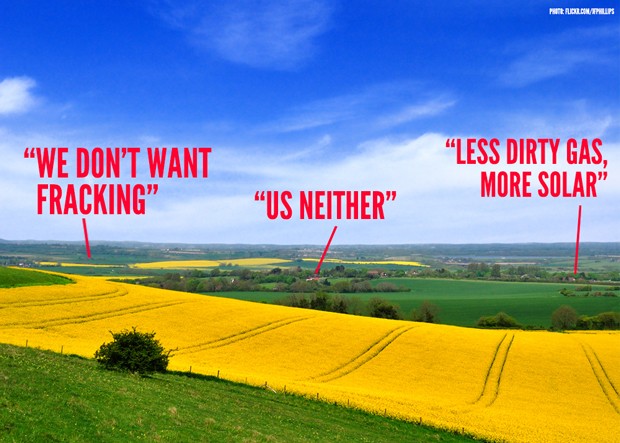If you live in (or near) the South Downs and care about how fracking could impact the area, here's a guide to how you can take part in the latest public consultation. Read on for a step by step guide and a few talking points. And importantly please remember to have your comments sent in by 5PM on Thursday 22 May, as that's when the consultation closes.
First, some background...
Earlier this year, more than 1,600 people – from all across Sussex – responded to the National Park Authority’s previous public consultation on fracking. So many comments were received that their website crashed. But most of all, thanks to the incredible public response, Celtique were forced onto the back foot and their plans to frack for gas were pushed back.
With Celtique having now announced that they're rolling back their plans to drill under homes, this could be the final nail in the coffin for plans to frack in the South Downs -- if enough of us speak up again. So please, follow the instructions above to leave your comment.
How to take part
Step 1: Open the consultation page here, then get started by registering (look for the register button toward the top of the page). You’ll need your email and postal addresses handy.
Step 2: Once registered, add your comment by clicking the ‘make a public comment button’ - we’ve prepared a few talking points below.
Step 3: When you’re done, please forward this email to 3 friends and encourage them to respond to the consultation too.
Talking points
Here are some suggestions of what you might like to put in your messages. Don't feel you have to include all of them - maybe pick two or three that resonate with you most.
Climate change
We need to leave these fossil fuels in the ground and invest in clean, renewable energy instead. The International Energy Agency warn that most of the gas and oil we've already found should stay in the ground if we are to avoid catastrophic climate change. The Planning Authority has a moral duty to future generations to ensure that these fossil fuels are not exploited. There is simply no justification for drilling for oil and gas in Sussex.
Undermines clean energy industries
Drilling for hard-to-reach fossil fuels in the South Downs countryside is madness: for the climate, for the environment, and for local communities. And what's more, doing so would play a role in undermining the growth of the UK's clean energy industries.
Industrialising the village of Fernhurst
Fernhurst is a quiet rural village in beautiful countryside. This application would industrialise the area – inundating the village with lorries and trucks (which will pass at least two schools), and creating air, noise and light pollution, as well as increasing the risk of road accidents.
Air pollution
The drilling operation could lead to flaring – which would have an increased adverse effect on local air pollution, not to mention increased greenhouse gas emissions.
Threat to ancient woodland
The site is surrounded on at least three sides by watercourses and by species-rich ancient woodland and hedgerows - this is a completely inappropriate place to site a drilling rig.
Soil contamination
There are no complete guarantees that this operation will not result in water or soil contamination, putting wildlife and ecosystems at risk. Celtique also have not provided any information on drilling fluids to be used, claiming this is a matter for the Environment Agency not the SDNPA.
Traffic
In their traffic survey, Celtique has massaged the data heavily in their favour by classifying any vehicle over 1.5 tons (equivalent to a Volvo estate) as an HGV and so have come up with an HGV traffic increase of less than 30% which they maintain will have negligible impact on the road and local residents. However, if an HGV is properly classified, then a recent independent traffic survey shows that the increase of HGV traffic along Vann Road would be 2,000%.
Threat to historic sites and tourism
The site is also close to the delicate archaeology of the Furnace Pond, and within a hundred metres of private dwellings, agricultural and tourism-based businesses.
Regulation difficulties
The UK regulatory framework is fragmented and has not been brought up to date to deal with new developments in the onshore oil and gas industry. With relevant agencies also facing budget cuts, it is very hard to see how the agencies responsible for monitoring compliance have or will have the capacity or capability to properly monitor and regulate companies like Celtique to protect local communities and the environment.
Lack of clarity around accident or pollution clean up
In addition, there is no clarity about who would accept ultimate responsibility if pollution or accident were to occur at a future date - would the SDNPA be left with the liability for trying to clean it up?
Evidence-based risks
The government has repeatedly made claims that the UK could benefit from a US-style revolution in shale gas exploration. Yet the evidence coming from the US is deeply worrying, where shale oil and gas operations were pushed ahead without an understanding of the true implications or consequences. More information about the worrying consequences of oil and shale exploration and fracking can be found in this evidence-based report, which I invite the members of the Planning committee to read: http://issuu.com/greenpeace/docs/fracking_-_the_evidence_
Further arguments
You can find more talking points and background reading on the Frack Free Fernhurt website: www.frackfreefernhurst.com
Visit the consultation website to add your response to fracking in the South Downs
Alternatively you can also write to the council directly at: South Downs National Park Authority c/o WSCC Planning, 2nd Floor Northleigh, County Hall, Chichester, PO19 1RH. Make sure you quote the reference number: SDNP/13/05896/CM
Please do share any responses you get from the South Down National Park Authority in the comments section below.



